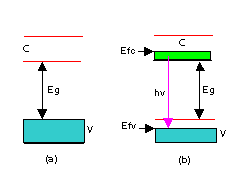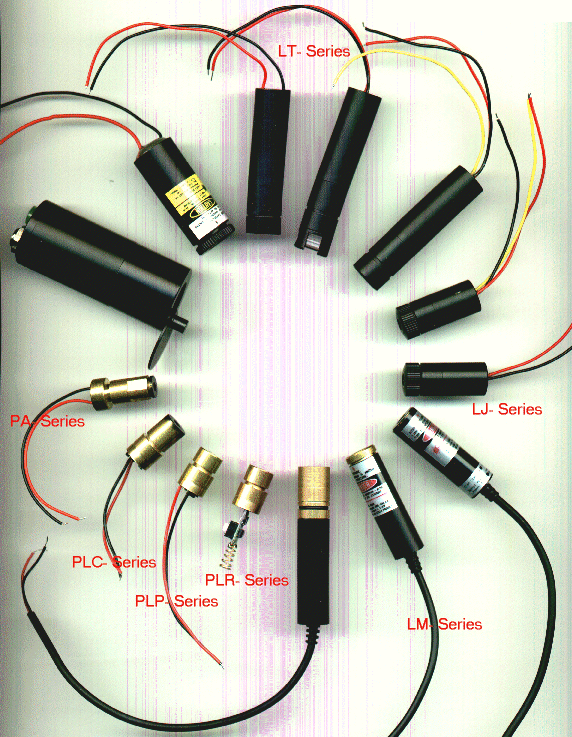Section 2.12: Types of Lasers — Semiconductor Lasers
Semiconductor lasers are said to be "the laser of the future". The reasons are: they are compact, they have the potential of mass production, they can be easily integrated, their properties are in rapid improvement, they are becoming more and more powerful and efficient and they have found a widespread use as pumps for solid–state lasers.
The majority of semiconductor materials are based on a combination of elements in the third group of the Periodic Table (such as Al, Ga, In) and the fifth group (such as N, P, As, Sb) hence referred to as the III-V compounds. Examples include GaAs, AlGaAs, InGaAs and InGaAsP alloys. The cw laser emission wavelengths are normally within 630~1600 nm, but recently InGaN semiconductor lasers were found to generate cw 410 nm blue light at room temperature. The semiconductor lasers that can generate blue-green light uses materials which are the combination of elements of the second group (such as Cd and Zn) and the sixth group (S, Se).
The principle of semiconductor laser is very different from CO2 and Nd:YAG lasers. It is based on "Recombination Radiation". We can explain this principle by referring to the following figure.

Figure 2.18: Principles of semiconductor lasers
The semiconductor materials have valence band V and conduction band C, the energy level of conduction band is Eg (Eg>0) higher than that of valence band. To make things simple, we start our analysis supposing the temperature to be 0 K. It can be proved that the conclusions we draw under 0 K applies to normal temperatures.
Under this assumption for nondegenerate semiconductor, initially the conduction band is completely empty and the valence band is completely filled. Now we excite some electrons from valence band to conduction band, after about 1 ps, electrons in the conduction band drop to the lowest unoccupied levels of this band, we name the upper boundary of the electron energy levels in the conduction band the quasi-Fermi level Efc. Meanwhile holes appear in the valence band and electrons near the top of the valence band drop to the lowest energy levels of the unoccupied valence energy levels, leave on the top of the valence band an empty part. We call the new upper boundary energy level of the valence band quasi-Fermi level Efv. When electrons in the conduction band run into the valence band, they will combine with the holes, in the same time they emit photons. This is the recombination radiation. Our task is to make this recombination radiation to lase. Then several conditions must be met.
First for the radiation to be amplified, the light energy hn must satisfy:
Efc - Efv ³ hn ³ Eg
From this relation we have Efc - Efv ³ Eg. This decides the critical condition. The value of Efc and Efv is influenced by the pumping process, i.e., by the intensity (N) of the electrons being raised to the conduction band. When N is increased, Efc increases and Efv decreases. The N satisfies Efc - Efv = Eg is named Ntr. We inject carriers into the semiconductor material to make the free electron intensity to be larger than Nth, then the semiconductor exhibits a net gain. We put this active medium in a suitable cavity, laser action occurs when this net gain overcome losses. The pumping of semiconductor lasers can be realized by the beam of another laser, or by an electron beam, but the most convenient way is by using electrical current that flows through the semiconductor junctions. This uses the semiconductor laser in the form of diode.
The early semiconductor lasers are Homojunction Lasers, which can operate cw only at cryogenic temperatures (like T=77K). Homojunction means the laser devices use the same material for both the p and n sides of the junction. The homojunction lasers were replaced by double-heterostructure (DH) lasers which can operate at room temperatures. The active medium of DH laser is sandwiched between p and n materials, the p and n materials differ from the active material.
The dimension of semiconductor laser is very small, a typical value is 100m m *200m m *50 m m. The power conversion efficiency is a few percent for the low power units and can reach 30% for laser arrays. The output power increases with the volume of the active layers, linear or stacked diode laser arrays can generate up to 20W cw and peak power up to 100W in quasi-CW operation. A problem with the semiconductor laser is its relatively large divergence angle (typical value 1~30 degrees), but its defects are being improved quickly. Lower power diode laser systems, of a few mW, are used in CD players, optical storage systems, laser printers and communications. Diode lasers with Power 0.5W/diode are available, when they are packed into arrays, they can generate power of several kW. As we mentioned before, semiconductor lasers are developing quickly, the cost will be greatly reduced when they can be mass produced. A very important application of diode lasers is for pumping other high energy laser systems such as Nd:YAG lasers. We will discuss this technique in advanced level.

G 2.10: Pictures of diode lasers (Courtesy of Lasermate Corporation)
Congradualations! You have reached the end of chapter 2, level two. Hoping you are not getting so bored. Please do the following chapter quiz, then move on to next chapter, or you can jump to Level Three of this chapter for deeper understanding of Laser Basics.